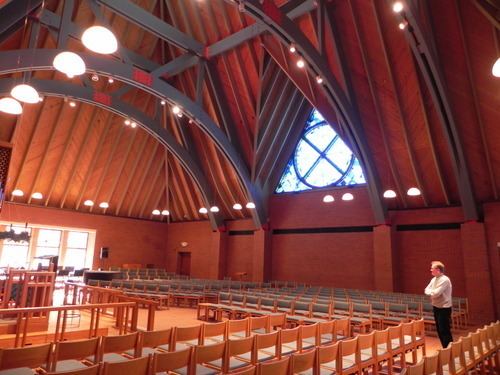Nationality American Design Church architecture Occupation Architect Name Edward Sovik | Spouse(s) Genevieve; Anne Role Author Children 5 | |
 | ||
Died May 4, 2014, Northfield, Minnesota, United States Books Accessible Church Buildings Alma mater | ||
Edward Anders Sövik, also Sovik, (June 9, 1918 - June 4, 2014) was an American architect and author. His most influential book, Architecture for Worship, covered the modern period in church architecture.
Contents
Early life
Sövik was born in 1918 in Henan province, China, a child of missionaries. After 17 years in China, Edward moved to the United States with his older sister and twin brother to attend college at St. Olaf College in Northfield, Minnesota. Professor Arnold Flaten influenced Edward to study art; Flaten had designed the Art Barn on campus. Sövik graduated in 1939. Edward moved to New York City to study painting at the Art Students League, then returned to Saint Paul, Minnesota, to study theology at Luther Seminary.
In the summer of 1941, sensing the inevitability of war, Ed Sövik enlisted in the Marine Corps. He served during the Second World War as a night fighter pilot in the Pacific theater, and was awarded a Purple Heart and a Distinguished Flying Cross. After the war, Sövik studied at Yale University's architecture program, then returned to Northfield, Minnesota, to start an architecture firm and teach at St. Olaf College.
Architecture career
As a practicing architect, Edward Sövik focused on churches and institutional buildings. He designed buildings for his alma mater and employer St. Olaf College, Carleton College, Concordia College (Moorhead, Minnesota), Stevens College, and the University of Minnesota. In addition to leading the company Sovik, Mathre & Madson (now SMSQ Architects), Sövik was President of the American Institute of Architects Minnesota chapter.
Sövik was also a professor of art at St. Olaf College. He designed, or assisted in the design of, 20 buildings on campus. As a professor, Sövik published many monographs and articles. He cites six scholars as influences on his work leading up to the 1973 publication of Architecture for Worship: liturgist Gregory Dix, liturgical architecture scholar J. G. Davies, liturgical historian Josef Jungmann, Langer, theologian and church historian Hans Lietzmann, and Lohmeyer. In this text, Sövik argued for church spaces that are not set apart for holy rituals, but are adaptable and suitable as "non-church" buildings.
Legacy and honors
Sövik received more than a dozen state and national design awards. He was named a Member of the American Institute of Architects in 1953 and a Fellow of the American Institute of Architects in 1967. In 1981 he was the first recipient of the Edward S. Frey Award from the AIA Interfaith Forum on Religion, Art, and Architecture. Modern Liturgy magazine named him the "most influential liturgical architect of the past twenty years".
